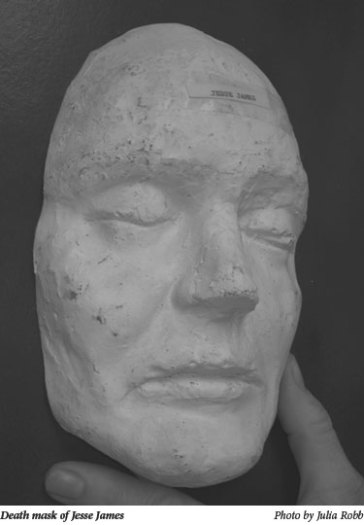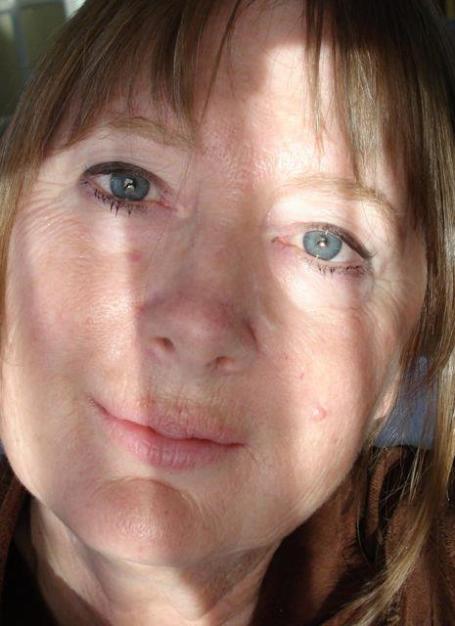I’m standing in the Midland County (Texas) public library basement staring down at six plaster of paris death masks.
Jesse James, Butch Cassidy, Bill Dalton, Robert Ford, Wild Bill Hickok and Clay Allison lay in a waist–high glass display case, with their eyes closed.


Bill Dalton’s tongue is stuck between his lips, Bob Ford is wearing a half smile, as if he’s not really happy at the company he’s keeping but wants to be polite. Butch Cassidy is sneering with swollen, cruel lips and broad, flaring nostrils, and Jesse James looks fast asleep.
In case you don’t know about these notorious men, here are the facts.
• Jesse James was a bank-robbing desperado and killer from the time he left Bloody Bill Anderson’s Southern guerillas until he was murdered in 1882. He was 34.

• Robert Ford was the shiftless young man who pretended to love Jesse, got close to him and then shot him in the back.
Jesse was killed in his own house, in St. Joseph, Missouri, while hanging a framed needlepoint on the wall.
Robert expected the public to praise and respect him because he killed the most famous outlaw in history, but people universally scorned him. A famous song referred to him as a “dirty little coward.”
In 1892, someone took a sawed off shotgun and filled Robert full of buckshot.
• Bill Dalton was a stage, train and bank robber whose career ended in 1894, at his home in Ardmore, Oklahoma, after he pulled his pistol and charged a posse.
Bill was 28 and so famous The Eagles (in the early 70s) recorded Doolin Dalton, a song about Bill and his brothers; “Easy money an’ faithless women Redeye whiskey for the pain.”
• Butch Cassidy, alias Robert Leroy Parker, began rustling cattle and robbing trains at a young age, accompanied by his good buddy Harry Longabaugh, alias “The Sundance Kid.”
Butch and Sundance were members, when they felt like it, of “The Hole in the Wall” gang.
Most of the time, Butch and Sundance confined their activities to the Utah-Wyoming area.
But when Butch was about 40, things got so hot he and Sundance relocated to Bolivia, where they were later killed.
These events are recorded in the movie Butch Cassidy and the Sundance Kid, starring Paul Newman and Robert Redford.
Bodies were never recovered.
When the movie was released, Butch’s youngest sister claimed Butch faked his death and eventually returned home.
But she did not produce a body.
• James Butler (Wild Bill) Hickok was the real deal. The ex-Union soldier was a scout, a lawman and a deadly man with a gun.
Wild Bill was killed in 1876, when he was 39, while playing poker in a Deadwood (Dakota Territory) saloon.
Broken Nose Jack McCall shot Hickok in the back of the head while reportedly saying, “Take that.”
• Clay Allison, a restless rancher who lived in Texas and New Mexico, may or may not have gunned down numerous men.
The law charged Allison with murder or manslaughter, more than once, but he was always acquitted.
Something was going on. Allison bragged he never killed a man who “didn’t need killing.”
Allison died at 46 after he fell off a wagon and it ran over him. He was probably drunk.
I stared at the masks in the Midland library for four years, from the time I was fourteen (when my family moved to Midland), to 18, when we moved to Abilene, Texas.
But I could never forget those brittle, gray faces.
The masks were part of the reason I became an historical novelist. They ignited my imagination.
I don’t like thieves and murderers and have no use for men who play with guns. What a waste of spirit.
The masks ignited me because when I stared at them I was looking at time. The men who modeled the masks were once alive, they experienced the world like I do, perceived the world revolving around them like I do, like everybody does.
And now they lay frozen in a library basement.
Well, I did write Scalp Mountain, a novel set in 1876, on the Texas frontier. So maybe the desperados influenced me more than I thought.
But through the years, I learned so much about Old West bad men I began doubting the masks.
Butch Cassidy was missing in action but his death mask was on display in Midland?
Cut to 2007.
I pitched a story about the masks to The Texas Observer, was hired to do a story and drove to Midland, to see the masks again.
The six bad men were now stored at the county museum, but they were still in the glass case and I recognized them as soon as I saw them.
I was right. These can’t be the real desperados.
Not only is Butch missing in action, he never had flared nostrils or a pouty mouth as the mask does.
Wild Bill’s mask doesn’t look anything like his photograph.
The real life Hickok had an oval chin, a long oval face, and a hooked nose. The death mask has a completely different shape.
Maybe the Ford mask is the real thing. Both the mask and Ford’s photograph have rounded chins.
But…if one mask is a fake, why would any of the masks be authentic?
And if these men are not who they are purported to be, who are they?
Somebody bought the masks in a Chicago antique store in the early 1960s and gave them to the museum.
So, did men executed on the (now defunct) Illinois death row model the masks?
How about men who were shot to death during Chicago’s St. Valentine’s Day Massacre, in 1929?
Today, Monday, March 4, after I decided to write this column, I looked at the mask photographs.
So, I looked at the masks, from 1962 to 1966, at least 120 times (I went to the library almost every week), looked again in 2007 and looked again today, in 2013.
I know less about the masks than I did in 1962.
Who are these masked men?
Julia Robb is author of Saint of the Burning Heart and Scalp Mountain. Julia can be reached at juliarobbmar@aol.com, venturegalleries.com, Facebook, Twitter, IAmATexan.com and Pinterest.
Click below to browse Julia Robb’s books:

